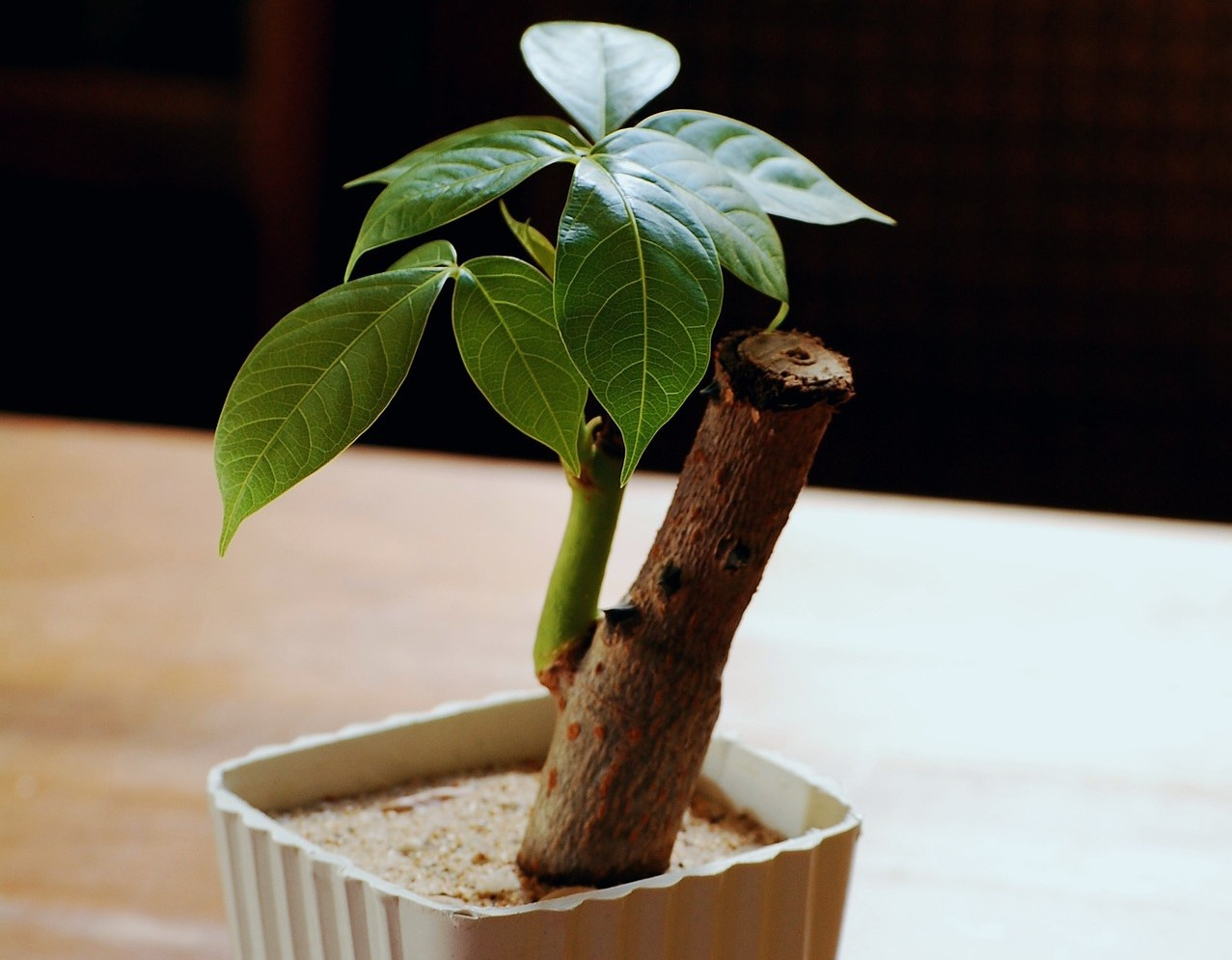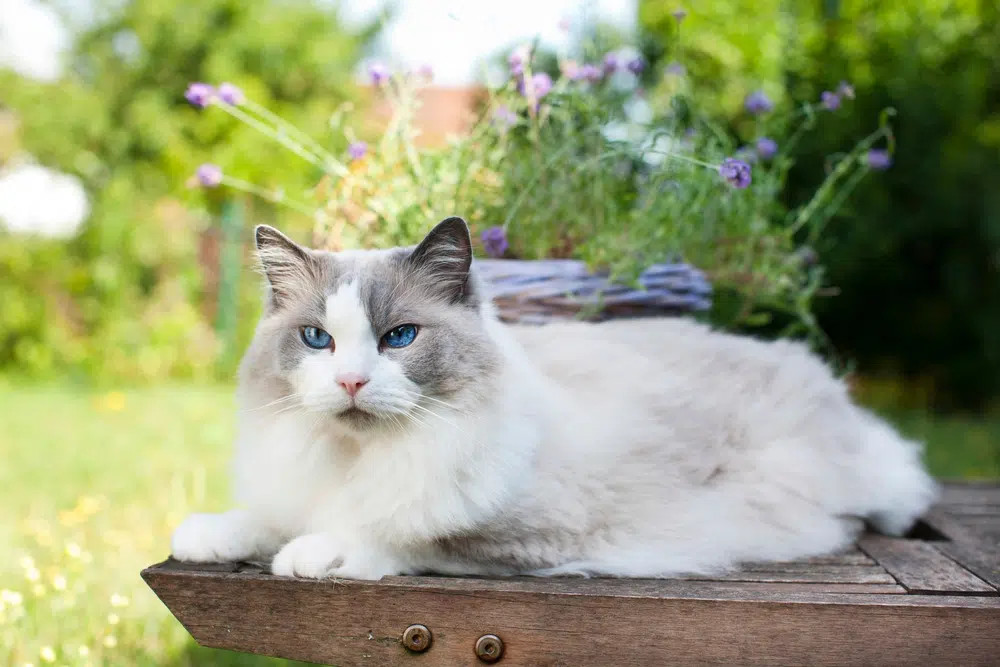Are money trees safe for your feline friend? This article from solcat.net answers your question and provides tips for keeping your cat safe around houseplants, ensuring a harmonious home for both you and your furry companion. Explore our expert advice, understand feline behavior, and discover ways to create a happy, healthy environment for your beloved cat.
1. What Exactly Are Money Trees?
Money trees, scientifically known as Pachira aquatica, are tropical trees that originate from Central and South America. These trees thrive in swampy environments and are easily identified by their distinctive twisted trunks and vibrant green leaves.
1.1 What are the unique characteristics of Money Trees?
Money trees are popular houseplants due to their resilience and appealing appearance. Their braided trunks and lush foliage make them a decorative addition to any indoor space. According to a study by the University of Florida IFAS Extension, Pachira aquatica can adapt to a variety of indoor conditions, making them an excellent choice for both beginner and experienced plant owners.
1.2 Where do Money Trees grow best?
Money trees thrive in bright, indirect light and prefer well-draining soil. It’s crucial to avoid overwatering, as their roots are susceptible to rot. The University of California, Davis, recommends watering only when the top inch of soil feels dry to the touch. Maintaining a consistent temperature between 65°F and 75°F (18°C and 24°C) is ideal for their growth.
2. Can Money Trees Potentially Harm Cats?
While money trees are generally considered non-toxic to cats, ingesting any plant material can still cause gastrointestinal upset. It’s important to monitor your cat and prevent them from consuming large quantities of the plant.
2.1 What are the symptoms of plant ingestion in cats?
If your cat eats part of a money tree, they might experience mild symptoms such as diarrhea, nausea, and vomiting. According to the ASPCA, these symptoms are typically self-limiting and resolve within 24-48 hours. However, if your cat shows signs of severe distress, such as persistent vomiting or lethargy, it’s essential to contact your veterinarian immediately.
2.2 Are there any benefits of Money Tree for Cats?
Money trees do not offer any nutritional benefits to cats. Cats are obligate carnivores, meaning their diet should primarily consist of meat. Plants like money trees lack the essential nutrients that cats need to maintain their health.
 Money Plant in a white pot on a table
Money Plant in a white pot on a table
2.3 What can I do to prevent my cat from eating my Money Tree?
To prevent your cat from nibbling on your money tree, consider placing the plant in an area that is inaccessible to your cat. Hanging planters or shelves can keep the plant out of reach. Additionally, you can use deterrent sprays that are safe for plants but unpleasant for cats, such as those with a citrus scent.
3. What Makes Money Trees So Appealing to Cats?
Cats are naturally curious and playful, often drawn to houseplants due to their movement, texture, and visual appeal. Money trees, with their dangling leaves and bright green color, can be particularly enticing to cats.
3.1 How do I keep my cat entertained so they stay away from my Money Tree?
Boredom is a primary reason cats play with plants. Providing your cat with plenty of interactive toys, such as feather wands, puzzle feeders, and laser pointers, can redirect their attention away from your houseplants. Regular play sessions not only entertain your cat but also strengthen your bond.
3.2 What are some alternatives for cats to play with instead of my Money Tree?
Consider offering cat-friendly alternatives like catnip-filled toys or a designated “cat garden” with safe plants such as cat grass or oat grass. These options satisfy your cat’s natural instincts to chew and play with vegetation without posing a risk to their health.
3.3 Can I use catnip to deter my cat from my Money Tree?
While catnip is great for engaging cats, using it near your money tree could backfire. The goal is to keep your cat away from the plant, not attract them to it. Instead, reserve catnip for specific toys or areas away from your houseplants.
4. How To Identify If A Plant Is Toxic?
Determining whether a plant is toxic can be challenging, but there are several indicators to watch out for. Recognizing these signs can help you make informed decisions about the plants you keep in your home.
4.1 What are the signs that a plant may be toxic to cats?
Plants with milky sap, shiny leaves, white or yellow berries, or umbrella-shaped foliage are often toxic. According to the Pet Poison Helpline, these characteristics are common among poisonous plants. Always research a plant thoroughly before bringing it into your home.
4.2 What resources can I use to check if a plant is toxic to cats?
Reliable resources such as the ASPCA’s Toxic and Non-Toxic Plant List and the Pet Poison Helpline website provide comprehensive information on plant toxicity. Consulting these resources can help you identify potentially harmful plants and ensure your cat’s safety. Solcat.net also offers detailed guides and articles on pet-safe plants.
4.3 When should I contact a vet if I suspect my cat has ingested a toxic plant?
If you suspect your cat has ingested a toxic plant, contact your veterinarian or the Pet Poison Helpline immediately. Provide as much information as possible about the plant and your cat’s symptoms. Prompt action can minimize the risk of serious complications.
5. Essential Tips To Keep Your Cat Safe From Toxic Houseplants
Protecting your cat from toxic houseplants involves proactive measures to prevent ingestion and create a safe environment. By implementing these strategies, you can enjoy houseplants without compromising your cat’s well-being.
5.1 How can I physically separate my cat from my houseplants?
The easiest way to protect your cat from toxic plants is to keep them out of reach. Place plants on high shelves, hanging planters, or in rooms that your cat cannot access. Using plant stands or creating barriers can also deter your cat from getting close to the plants.
5.2 What scents do cats dislike, and how can I use them as a deterrent?
Cats are generally averse to citrus scents. You can use citrus peels or diluted citrus sprays around your plants to deter your cat. However, be cautious, as the acidity in citrus can harm some plants. Other scents that cats dislike include lavender, rosemary, and eucalyptus.
5.3 How does trimming houseplants help keep cats away?
Dangling leaves and stems are particularly tempting for cats. Regularly trimming your houseplants and removing any loose or dangling parts can make them less appealing to your cat. This also helps maintain the plant’s health and appearance.
 Adult-ragdoll-cat-lying-relaxed-in-the-garden
Adult-ragdoll-cat-lying-relaxed-in-the-garden
5.4 Can I use commercial cat deterrents around my houseplants?
Yes, there are several commercial cat deterrents available that can help keep your cat away from houseplants. These products often contain natural ingredients that cats find unpleasant. Always choose a deterrent that is safe for both your cat and your plants.
5.5 How important is it to provide enrichment for my cat to keep them away from my houseplants?
Providing ample enrichment for your cat is crucial in preventing them from engaging with houseplants. Enrichment can include interactive toys, scratching posts, climbing structures, and puzzle feeders. A stimulated cat is less likely to seek entertainment from your plants.
6. Creating A Cat-Friendly Home Environment
Designing a home that caters to both your plants and your cat requires careful planning and consideration. By understanding your cat’s natural behaviors and creating a stimulating and safe environment, you can enjoy a harmonious living space.
6.1 How can I make my home more cat-friendly?
Creating a cat-friendly home involves providing vertical spaces for climbing, comfortable resting areas, and plenty of toys. Cats enjoy having elevated vantage points, so consider installing shelves or cat trees. Regularly rotate toys to keep your cat engaged and prevent boredom.
6.2 What are the best plants to keep in a cat-friendly home?
When choosing plants for a cat-friendly home, opt for non-toxic varieties such as spider plants, cat grass, and bamboo palms. These plants are safe for cats to nibble on and can add greenery to your home without posing a health risk.
6.3 How can I balance having plants and cats in my home?
Balancing plants and cats in your home requires a combination of prevention, enrichment, and monitoring. Keep toxic plants out of reach, provide plenty of alternative entertainment for your cat, and regularly inspect your plants for signs of damage. With a little effort, you can create a space that is both beautiful and safe for your feline companion.
7. Other Common Houseplants and Their Toxicity to Cats
Understanding the toxicity levels of common houseplants is crucial for cat owners. Knowing which plants to avoid can help you create a safer environment for your feline friend.
7.1 What are some common toxic houseplants to avoid?
Common toxic houseplants include lilies, daffodils, azaleas, and oleander. Lilies are particularly dangerous, as even small amounts can cause kidney failure in cats. The ASPCA provides a comprehensive list of toxic plants to help you make informed choices.
7.2 What are some safe alternatives to toxic houseplants?
Safe alternatives to toxic houseplants include spider plants, African violets, and ferns. These plants are non-toxic to cats and can add beauty to your home without posing a risk to your pet’s health.
7.3 How can I identify if a houseplant is safe for cats?
Always research a plant thoroughly before bringing it into your home. Consult reliable resources such as the ASPCA’s Toxic and Non-Toxic Plant List or the Pet Poison Helpline website. When in doubt, choose plants that are known to be safe for pets.
8. Understanding Feline Behavior and Plant Interaction
Understanding why cats interact with plants can help you develop effective strategies to protect both your feline friend and your houseplants.
8.1 Why do cats chew on plants?
Cats may chew on plants for a variety of reasons, including curiosity, boredom, and digestive upset. Some cats may also chew on plants to help relieve intestinal discomfort or to add fiber to their diet.
8.2 How can I redirect my cat’s chewing behavior?
To redirect your cat’s chewing behavior, provide them with alternative chewing options such as cat grass or chew toys. Regularly engaging your cat in play can also help reduce boredom and prevent them from seeking entertainment from your plants.
8.3 What role does diet play in a cat’s interest in plants?
A balanced diet can play a role in reducing a cat’s interest in plants. Ensure your cat is receiving adequate fiber and nutrients in their diet. If you suspect your cat is chewing on plants due to a dietary deficiency, consult with your veterinarian.
9. Latest Research and Studies on Plant Toxicity in Pets
Staying informed about the latest research and studies on plant toxicity in pets is essential for providing the best possible care for your feline companion.
9.1 What are some recent findings on plant toxicity in cats?
Recent studies have focused on identifying specific toxins in plants and their effects on cats. Researchers are also exploring new methods for treating plant poisoning in pets.
9.2 Where can I find reliable information on plant toxicity research?
Reliable sources of information on plant toxicity research include veterinary journals, university websites, and pet health organizations such as the ASPCA and the Pet Poison Helpline.
9.3 How can I use this information to protect my cat?
Use the latest research and information on plant toxicity to make informed decisions about the plants you keep in your home. Regularly review your houseplants and ensure they are safe for your cat. Stay vigilant and monitor your cat for any signs of plant ingestion.
10. Expert Opinions on Cats and Houseplants
Hearing from veterinarians and animal behaviorists can provide valuable insights into managing cats and houseplants.
10.1 What do veterinarians recommend for keeping cats safe around houseplants?
Veterinarians recommend keeping toxic plants out of reach, providing alternative chewing options, and monitoring your cat for signs of plant ingestion. Regular check-ups with your veterinarian can also help ensure your cat’s overall health and well-being.
10.2 What do animal behaviorists suggest for managing a cat’s interaction with plants?
Animal behaviorists suggest providing ample enrichment, redirecting chewing behavior, and creating a stimulating environment to reduce a cat’s interest in plants. Understanding your cat’s natural instincts and providing appropriate outlets can help prevent unwanted behaviors.
10.3 How can I find a qualified veterinarian or animal behaviorist?
You can find a qualified veterinarian or animal behaviorist through referrals from friends, family, or your local veterinary clinic. Online directories and professional organizations can also help you locate qualified professionals in your area.
11. Solcat.net: Your Ultimate Resource for Cat Care
At solcat.net, we are dedicated to providing reliable, up-to-date information on all aspects of cat care. Our comprehensive resources cover everything from nutrition and health to behavior and enrichment.
11.1 What resources does solcat.net offer for cat owners?
Solcat.net offers a wide range of resources for cat owners, including articles, guides, and product reviews. Our expert advice is designed to help you provide the best possible care for your feline companion.
11.2 How can solcat.net help me create a safe and happy home for my cat?
Solcat.net provides practical tips and advice on creating a safe and happy home for your cat. From choosing the right plants to providing ample enrichment, our resources can help you create a harmonious living space for both you and your feline friend.
11.3 How often is the content on solcat.net updated?
The content on solcat.net is regularly updated to ensure it reflects the latest research and best practices in cat care. We strive to provide accurate, reliable information that you can trust.
12. Conclusion: Balancing Your Love for Cats and Houseplants
Caring for both cats and houseplants can be a rewarding experience. By understanding the potential risks and taking proactive measures to protect your feline friend, you can create a beautiful and safe home for both of you. Remember to stay informed, provide ample enrichment, and consult with your veterinarian or animal behaviorist when needed. Visit solcat.net for more information and resources on cat care.
The money tree is generally a safe choice for homes with cats. While it’s non-toxic, preventing your cat from munching on it is still a good idea. For more tips and resources on creating a cat-friendly home, visit solcat.net today. Explore our articles on feline behavior, safe houseplants, and enrichment activities to keep your furry friend happy and healthy. Remember, a well-informed pet owner is a responsible pet owner.
Frequently Asked Questions (FAQs)
1. Is the money tree plant really non-toxic to cats?
Yes, the money tree (Pachira aquatica) is generally considered non-toxic to cats. However, ingesting any plant material can cause mild gastrointestinal upset.
2. What should I do if my cat eats a part of my money tree?
Monitor your cat for symptoms such as vomiting, diarrhea, or lethargy. Contact your veterinarian if symptoms persist or worsen.
3. How can I stop my cat from eating my houseplants?
Keep plants out of reach, use deterrent sprays, provide alternative chewing options, and ensure your cat has plenty of enrichment.
4. Are there any plants that are safe for cats to eat?
Yes, cat grass, spider plants, and bamboo palms are safe for cats to nibble on.
5. What are some signs that a plant is toxic to cats?
Signs include milky sap, shiny leaves, white or yellow berries, and umbrella-shaped foliage.
6. Where can I find a list of toxic and non-toxic plants for cats?
The ASPCA and the Pet Poison Helpline provide comprehensive lists of toxic and non-toxic plants.
7. Can I use citrus scents to keep my cat away from my plants?
Yes, cats generally dislike citrus scents, but be cautious as citrus can harm some plants.
8. How important is it to provide enrichment for my cat?
Enrichment is crucial for preventing boredom and reducing your cat’s interest in plants.
9. What should I do if I suspect my cat has ingested a toxic plant?
Contact your veterinarian or the Pet Poison Helpline immediately.
10. Where can I find more information on cat care and plant safety?
Visit solcat.net for expert advice, articles, and resources on cat care and plant safety.
Navigating the world of cat ownership and houseplants doesn’t have to be daunting. Trust solcat.net to be your go-to resource for creating a safe, happy, and harmonious home for your beloved feline companion.
Address: 950 Alaskan Way, Seattle, WA 98104, United States
Phone: +1 (206) 386-4000
Website: solcat.net

